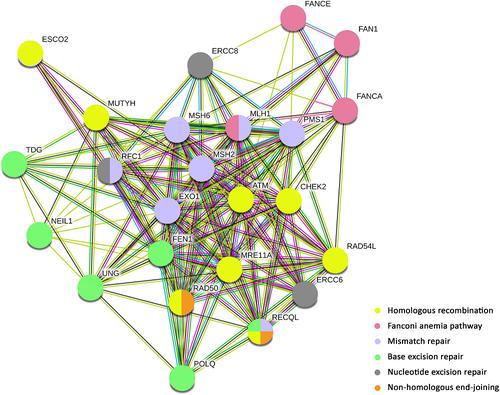当前位置:
X-MOL 学术
›
Hum. Mutat.
›
论文详情
Our official English website, www.x-mol.net, welcomes your
feedback! (Note: you will need to create a separate account there.)
Whole‐exome sequencing of non‐BRCA1/BRCA2 mutation carrier cases at high‐risk for hereditary breast/ovarian cancer
Human Mutation ( IF 3.3 ) Pub Date : 2020-12-16 , DOI: 10.1002/humu.24158 Paula S Felicio 1 , Rebeca S Grasel 1 , Natalia Campacci 1 , Andre E de Paula 2 , Henrique C R Galvão 3 , Giovana T Torrezan 4 , Cristina S Sabato 2 , Gabriela C Fernandes 2 , Cristiano P Souza 3 , Rodrigo D Michelli 3 , Carlos E Andrade 3 , Bruna Durães De Figueiredo Barros 4 , Marcus M Matsushita 5 , Timothée Revil 6 , Jiannis Ragoussis 6, 7 , Fergus J Couch 8, 9 , Steven N Hart 8, 9 , Rui M Reis 1, 2, 10, 11 , Matias E Melendez 1, 12, 13 , Patricia N Tonin 6, 14, 15 , Dirce M Carraro 4, 16 , Edenir I Palmero 1, 2, 12, 13
Human Mutation ( IF 3.3 ) Pub Date : 2020-12-16 , DOI: 10.1002/humu.24158 Paula S Felicio 1 , Rebeca S Grasel 1 , Natalia Campacci 1 , Andre E de Paula 2 , Henrique C R Galvão 3 , Giovana T Torrezan 4 , Cristina S Sabato 2 , Gabriela C Fernandes 2 , Cristiano P Souza 3 , Rodrigo D Michelli 3 , Carlos E Andrade 3 , Bruna Durães De Figueiredo Barros 4 , Marcus M Matsushita 5 , Timothée Revil 6 , Jiannis Ragoussis 6, 7 , Fergus J Couch 8, 9 , Steven N Hart 8, 9 , Rui M Reis 1, 2, 10, 11 , Matias E Melendez 1, 12, 13 , Patricia N Tonin 6, 14, 15 , Dirce M Carraro 4, 16 , Edenir I Palmero 1, 2, 12, 13
Affiliation

|
The current study aimed to identify new breast and/or ovarian cancer predisposition genes. For that, whole‐exome sequencing (WES) was performed in the germline DNA of 52 non‐BRCA1/BRCA2/TP53 mutation carrier women at high‐risk for hereditary breast and ovarian cancer (HBOC). All variants were classified using information from population and disease specific databases, in silico prediction tools and the American College of Medical Genetics and Genomics (ACMG) criteria. Loss of heterozygosity (LOH) of tumor samples and segregation analyses were performed whenever possible. The variants identified were investigated in a second, independent cohort of 17 BC cases. Pathogenic/Likely Pathogenic variants were identified in known cancer genes such as CHEK2, MUTYH, PMS2, and RAD51C. Rare and potentially pathogenic variants were identified in DNA repair genes (FAN1, POLQ, and RAD54L) and other cancer‐related genes such as DROSHA and SLC34A2. Interestingly, the variant c.149T>G in the FAN1 gene was identified in two unrelated families, and exhibited LOH in the tumor tissue of one of them. In conclusion, this is the largest Brazilian WES study involving families at high‐risk for HBOC which has brought novel insights into the role of potentially new genetic risk factors for hereditary breast and ovarian cancer.
中文翻译:

遗传性乳腺癌/卵巢癌高危非 BRCA1/BRCA2 突变携带者的全外显子组测序
目前的研究旨在确定新的乳腺癌和/或卵巢癌易感基因。为此,我们对 52名具有遗传性乳腺癌和卵巢癌 (HBOC) 高风险的非BRCA1/BRCA2/TP53突变携带者女性的种系 DNA 进行了全外显子组测序 (WES )。使用来自人口和疾病特定数据库的信息、计算机预测工具和美国医学遗传学和基因组学学院 (ACMG) 标准对所有变体进行分类。尽可能进行肿瘤样品的杂合性丢失(LOH)和分离分析。在 17 个 BC 病例的第二个独立队列中研究了确定的变体。致病性/可能的致病性变异在已知的癌症基因中被发现,例如CHEK2、MUTYH、PMS2和RAD51C. 在 DNA 修复基因(FAN1、POLQ和RAD54L)和其他癌症相关基因(如DROSHA和SLC34A2 )中发现了罕见且可能致病的变异。有趣的是, FAN1基因中的变异 c.149T>G 在两个不相关的家族中被发现,并在其中一个家族的肿瘤组织中表现出 LOH。总之,这是巴西最大的 WES 研究,涉及 HBOC 高危家庭,它为遗传性乳腺癌和卵巢癌的潜在新遗传风险因素的作用带来了新的见解。
更新日期:2021-02-10
中文翻译:

遗传性乳腺癌/卵巢癌高危非 BRCA1/BRCA2 突变携带者的全外显子组测序
目前的研究旨在确定新的乳腺癌和/或卵巢癌易感基因。为此,我们对 52名具有遗传性乳腺癌和卵巢癌 (HBOC) 高风险的非BRCA1/BRCA2/TP53突变携带者女性的种系 DNA 进行了全外显子组测序 (WES )。使用来自人口和疾病特定数据库的信息、计算机预测工具和美国医学遗传学和基因组学学院 (ACMG) 标准对所有变体进行分类。尽可能进行肿瘤样品的杂合性丢失(LOH)和分离分析。在 17 个 BC 病例的第二个独立队列中研究了确定的变体。致病性/可能的致病性变异在已知的癌症基因中被发现,例如CHEK2、MUTYH、PMS2和RAD51C. 在 DNA 修复基因(FAN1、POLQ和RAD54L)和其他癌症相关基因(如DROSHA和SLC34A2 )中发现了罕见且可能致病的变异。有趣的是, FAN1基因中的变异 c.149T>G 在两个不相关的家族中被发现,并在其中一个家族的肿瘤组织中表现出 LOH。总之,这是巴西最大的 WES 研究,涉及 HBOC 高危家庭,它为遗传性乳腺癌和卵巢癌的潜在新遗传风险因素的作用带来了新的见解。











































 京公网安备 11010802027423号
京公网安备 11010802027423号